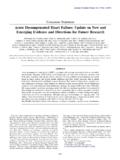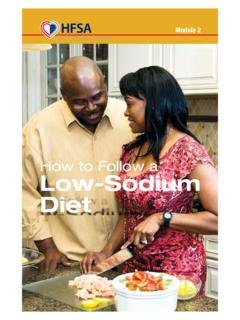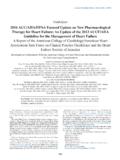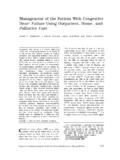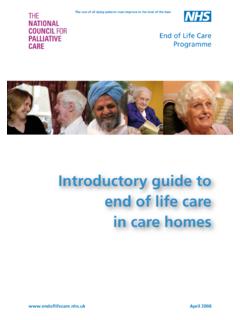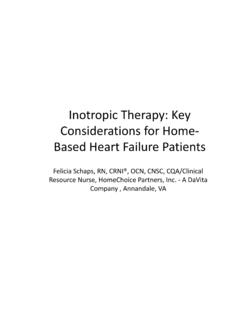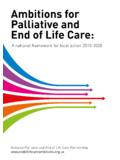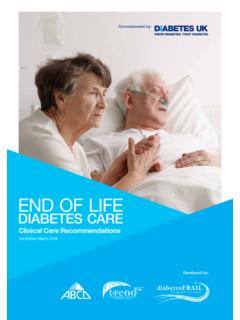Transcription of End-of-Life Care in Patients With Heart Failure
1 Consensus StatementEnd-of- life care in Patients with Heart FailureDAVID J. WHELLAN, MD, MHS,1 SARAH J. GOODLIN, MD,2 MICHAEL G. DICKINSON, MD,3 PAUL A. HEIDENREICH, MD, MS,4 CONNIE JAENICKE, NP, RN-C MSN,5 WENDY GATTIS STOUGH, PharmD,6 ANDMICHAEL W. RICH, MD,7ON BEHALF OF THE QUALITY OF care COMMITTEE, Heart Failure SOCIETY OF AMERICAP hiladelphia, Pennsylvania; Portland, Oregon; Grand Rapids, Michigan; Palo Alto, California; Minneapolis, Minnesota; Buies Creek, North Carolina; andSt. Louis, MissouriABSTRACTS tage D Heart Failure (HF) is associated with poor prognosis, yet little consensus exists on the care of pa-tients with HF approaching the end of life .
2 Treatment options for end-stage HF range from continuation ofguideline-directed medical therapy to device interventions and cardiac transplantation. However, patientsapproaching the end of life may elect to forego therapies or procedures perceived as burdensome, or todeactivate devices that were implanted earlier in the disease course. Although discussing End-of-Life issuessuch as advance directives, palliative care , or hospice can be difficult, such conversations are critical tounderstanding patient and family expectations and to developing mutually agreed-on goals of Patients with HF are at risk for rapid clinical deterioration or sudden cardiac death, end-of-lifeissues should be discussed early in the course of management.
3 As Patients progress to advanced HF,the need for such discussions increases, especially among Patients who have declined, failed, or beendeemed to be ineligible for advanced HF therapies. Communication to define goals of care for the indi-vidual patient and then to design therapy concordant with these goals is fundamental to patient-centeredcare. The objectives of this white paper are to highlight key End-of-Life considerations in Patients with HF,to provide direction for clinicians on strategies for addressing End-of-Life issues and providing optimal pa-tient care , and to draw attention to the need for more research focusing on End-of-Life care for the HF pop-ulation.
4 (J Cardiac Fail 2014;20:121e134)Key Words:Advanced Heart Failure , End-of-Life care , hospice, palliative Failure (HF) with either reduced ejection fraction(HFrEF) or preserved ejection fraction (HFpEF) is charac-terized by a broad range of symptoms. Patients with HFtend to follow a variable course after the initial insult (eg,coronary artery disease, myocardial infarction, genetic con-ditions, or environmental factors such as alcohol), but manyprogress owing to maladaptive remodeling and recurrentdamage to the myocardium leading to the development ofworsening symptoms.
5 The American College of CardiologyFoundation/American Heart Association (AHA) guidelinefor the management of HF characterizes HF progressioninto 4 stages, in which stage A includes individuals withrisk factors for HF but without structural Heart disease,stage B includes persons with structural Heart diseasewithout HF symptoms, stage C represents symptomaticHF, and stage D reflects refractory symptoms despiteguideline-directed medical therapy (GDMT).1 Although a large body of evidence has accumulated toguide the management of Patients with chronic HF, there islittle consensus on the care of these Patients near or at theend of life .
6 Many factors warrant consideration in this popu-lation, including prognosis, patient treatment goals, andavailable treatment options. Discussing End-of-Life issues,From the1 Department of Medicine, Jefferson Medical College, Phila-delphia, Pennsylvania;2 Division of General Internal Medicine and Geri-atrics, Portland Veterans Affairs Medical Center and Oregon Health andScience University, Portland, Oregon;3 Frederik Meijer Heart & VascularInstitute, Spectrum Health, Grand Rapids, Michigan;4 Center for HealthPolicy, Center for Primary care and Outcomes Research, Veterans AffairsPalo Alto Medical Center, Palo Alto, California.
7 5 Veterans Affairs MedicalCenter, Minneapolis, Minnesota;6 Campbell University College of Phar-macy and Health Sciences, Buies Creek, North Carolina and7 WashingtonUniversity School of Medicine, St. Louis, received July 19, 2013; revised manuscript receivedDecember 5, 2013; revised manuscript accepted December 6, requests: David J. Whellan, MD, MHS, Professor of Medicine,Jefferson University, 925 Chestnut Street, Mezzanine, Philadelphia,PA 19107. Tel: 215-955-2007; Fax: 215-503-7420. page 132 for disclosure $ - see front matter 2014 Elsevier Inc.
8 All rights of Cardiac Failure Vol. 20 No. 2 2014such as advance directives, palliative care or hospice, and de-vice deactivation, is critical to guiding patient and family ex-pectations and helping them to cope with terminal illness anddeath. Appropriate strategies can be used to improve HFsymptoms and quality of life throughout HF care , includingthe End-of-Life period. Recognizing that most HF Patients diebefore stage D, it is important to address dying early in thecourse of HF because of the risk of sudden death and poten-tial need for resuscitative measures.
9 Patients preferencesregarding End-of-Life care should be revisited periodicallyas the condition and prognosis the difficulty and complexities of End-of-Life is-sues in HF Patients , there is minimal evidence-based guid-ance to inform the care of this population. The objectives ofthis white paper are to highlight key End-of-Life consider-ations in Patients with HF, to provide direction for clini-cians on strategies for addressing End-of-Life issues andfor providing optimal patient care , and to draw attentionto the need for more research focusing on End-of-Life carefor the HF the Stage D HF PopulationEpidemiologyThe prevalence of stage D HF has not been well docu-mented.
10 Approximately million Americans$20 yearsof age have proportion of these Patients with stageD is uncertain, although it has been estimated to be 5%e10%.3 These figures suggest that there are300,000e600,000 Patients in the USA with stage D CharacteristicsThe Acute Decompensated Heart Failure National Reg-istry Longitudinal Module (ADHERE LM) enrolled 1,433patients with stage D HF. Patients with stage D HF wereyounger, more often male, and more likely to have a his-tory of dyslipidemia, coronary artery disease, and chronicrenal insufficiency than other Patients hospitalized foracute decompensated HF.


